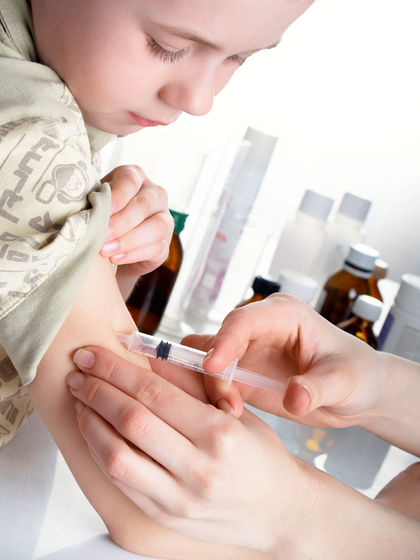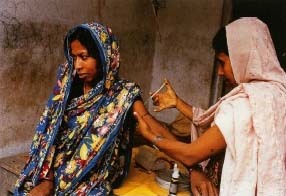Tetanus

Tetanus (TET-a-nus) is one of the oldest diseases known to afflict human beings. It is a disease that attacks the central nervous system, causing lockjaw and other symptoms. Tetanus is caused by infection of a wound by the bacterium Clostridium tetani.
KEYWORDS
for searching the Internet and other reference sources
Bacterial infection
Vaccination
What Is Tetanus?
The bacteria Clostridium tetani are present in soil and in animal feces. The bacteria can produce spores, which are a special form of the bacteria that is resistant to heat and disinfectants. When spores enter the skin through a wound, they can germinate into the more active form of Clostridium tetani. The bacteria can then produce a substance that is very toxic (poisonous) to human beings. This toxin causes the symptoms of tetanus.
Tetanus is a rare disease in the United States (about 100 cases a year) because children are routinely vaccinated against it. But the disease is more common in places that do not have rigorous immunization policies. In the United States people who get tetanus tend to be older; many of them have not been adequately immunized. Without treatment, tetanus can be fatal.
How Do People Get Tetanus?
People get tetanus through an infected open wound. If a person steps on a rusty nail, for example, he or she could become ill from the spores of the tetanus bacteria. The bacteria produce a substance that is toxic to the central nervous system. Because the spores cannot germinate and the

Once the bacteria have entered the body, it may take from 3 to 50 days (with an average of 5 to 10 days) for symptoms to appear.

What Are the Symptoms of Tetanus?
Stiffness of the jaw (lockjaw) is the most common symptom of tetanus. A person with tetanus has difficulty opening his or her mouth. Other muscles become stiff (back, abdomen, face). If the muscles of the face stiffen, a person with tetanus looks as if he or she has a fixed smile that does not change.
The patient may also have a fever, perspire heavily, have a rapid pulse, feel restless, and have muscle spasms. Noise and light may cause seizures in a person with tetanus. Infants with tetanus are unable to nurse because they lose their ability to suck.
How Is Tetanus Diagnosed and Treated?
There are no reliable tests for tetanus. The doctor makes a diagnosis from the symptoms a person has and from a recent history of open wounds. It is, unfortunately, easier for a doctor to diagnose tetanus in its later rather than its earlier stages. Some of the symptoms of tetanus could indicate a different disease.
The Discovery of Tetanus
The German physician Arthur Nicolaier discovered the tetanus bacillus in 1884. He was not able, however, to obtain a pure culture of the tetanus, which would have allowed him to study it more closely. Instead, he confirmed that the bacteria generated the tetanus toxin by injecting garden soil containing the bacteria into animals and observing the resultant symptoms of tetanus. Five years later, the Japanese bacteriologist Shibasaburo Kitasato cultivated the tetanus bacterium in pure culture and a year later developed an effective tetanus antitoxin. After World War I, English scientists developed an improved antitoxin that was put to use after World War II when the establishment of active immunization for all children became a standard practice.
When the doctor does determine that tetanus is present, the patient should be given an injection of tetanus antitoxin. The antitoxin contains antibodies that attach to and neutralize the tetanus toxin. The person is also immunized for tetanus. After being treated with antitoxin, the infected areas are cleansed thoroughly. Then antibiotics are given to the patient to destroy bacteria in the wound. Other drugs are given to control the symptoms that are present. In some cases, a mechanical ventilator (breathing machine) is needed to help regulate the person's breathing. The patient is kept in a dark and quiet environment, since light and noise stimulate symptoms of the disease.
Can Tetanus Be Prevented?
Tetanus can be prevented by vaccination. In combination with vaccines against diphtheria (a bacterial infection that causes sore throat and fever) and pertussis (whooping cough), a tetanus vaccination is given routinely to children in the United States. The vaccine will protect a person for 10 years, after which a booster shot is recommended. When a person has a serious wound to the skin and has not been immunized for over 10 years, tetanus antitoxin injections are administered as a precaution.
Resources
Henderson, Alan D. "Neonatal Tetanus." Health Letter on the CDC, December 28, 1998, p. 10.
The U.S. Centers for Disease Control and Prevention (CDC), 1600 Clifton
Road, N.E., Atlanta, GA 30333. The United States government authority
for information about infectious and other diseases, the CDC posts
information about tetanus at its website.
http://cdc.gov/nip/vaccine/nip-dtp.htm
Weinberg, Winkler. No Germs Allowed. New Brunswick, NJ: Rutgers University Press, 1996.
Comment about this article, ask questions, or add new information about this topic: